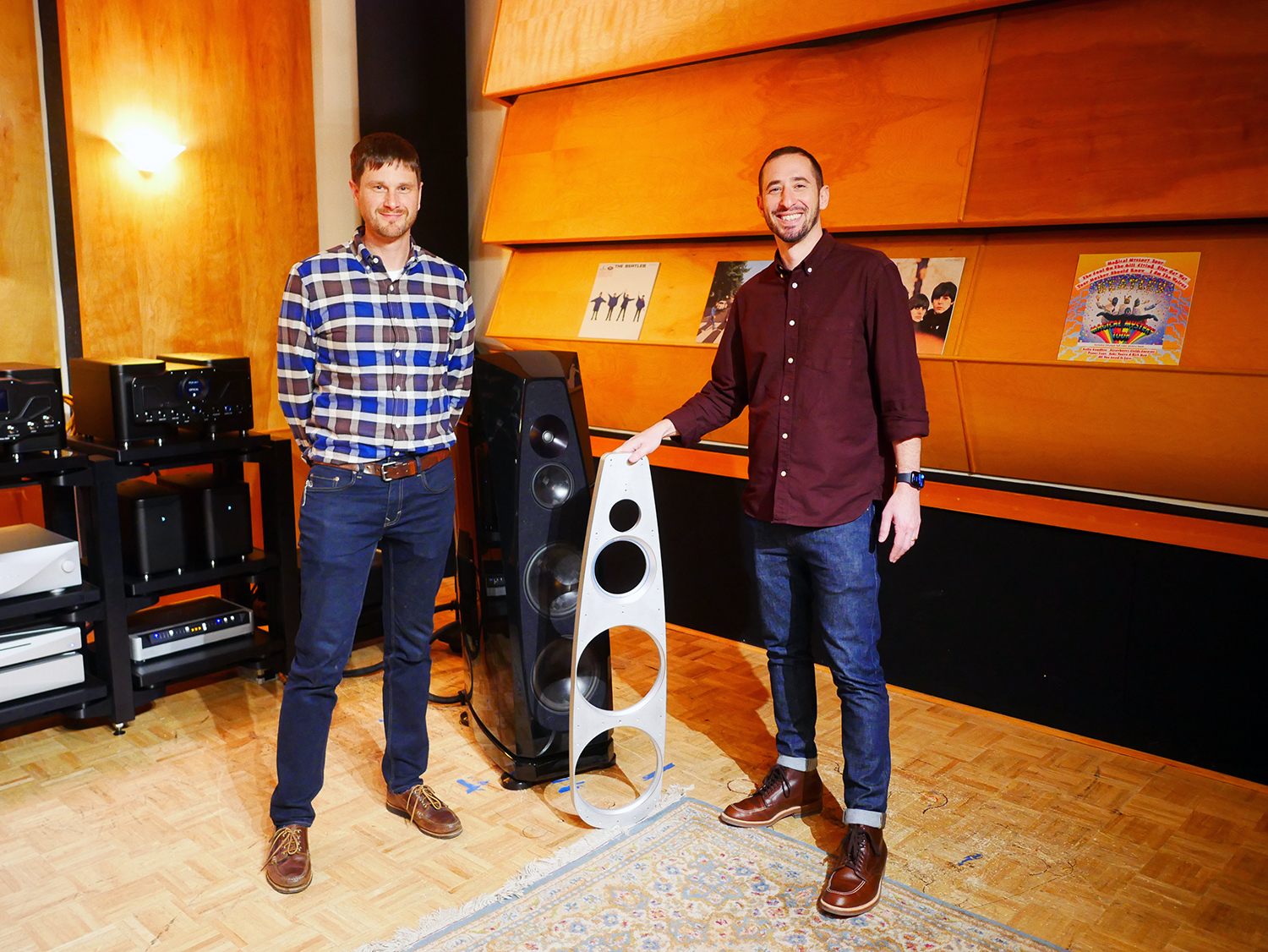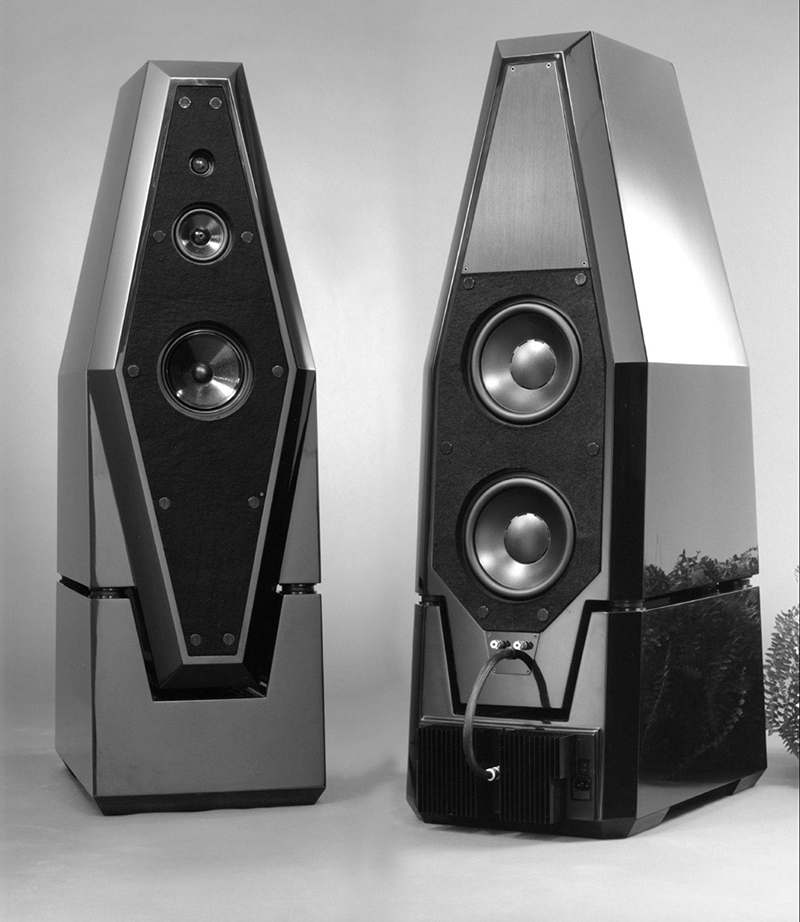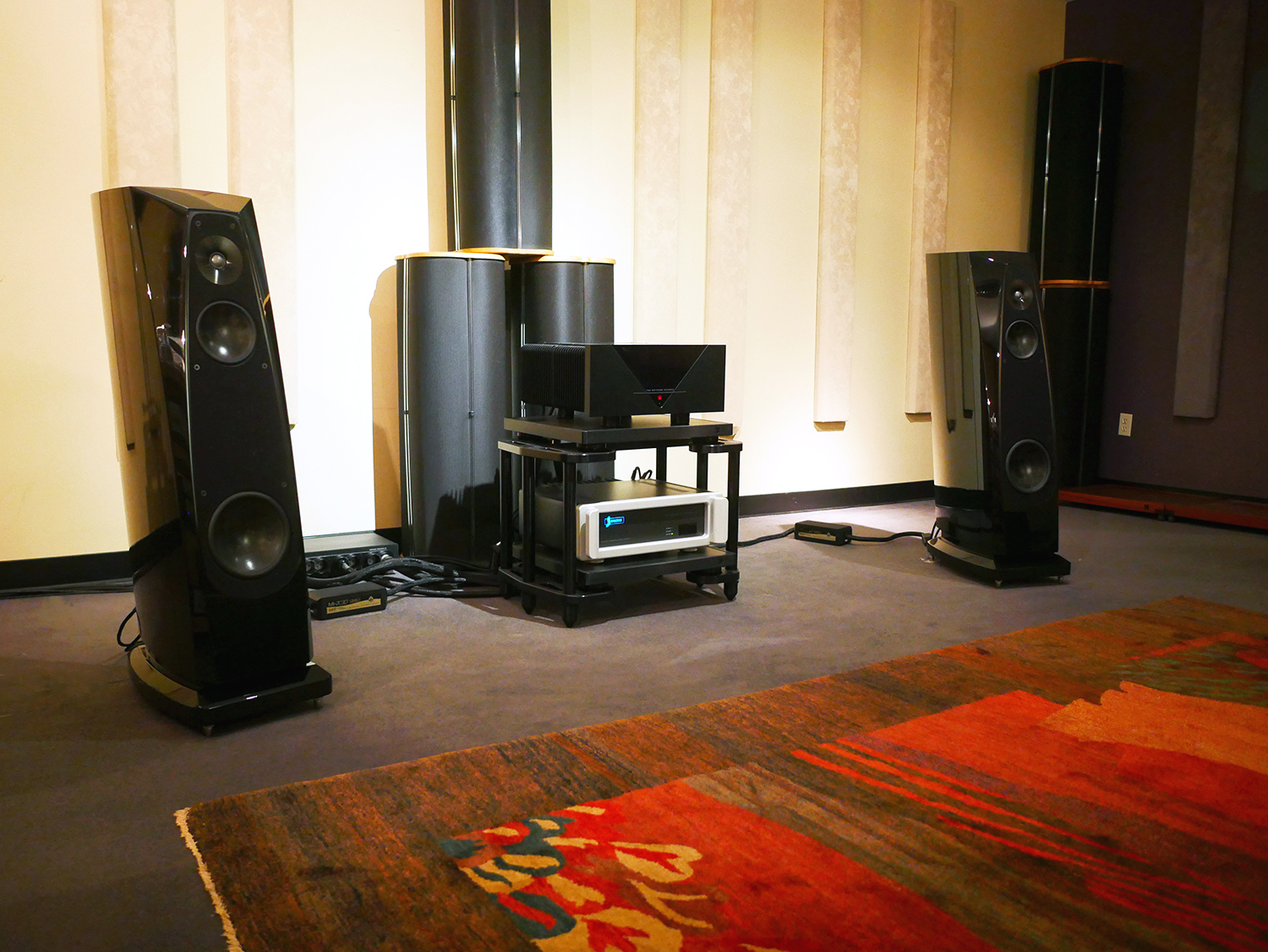
I have a Big HiFi Secret, two actually, and I’m ready to spill the beans.
- If you want to know everything there is to know about a piece of hifi gear, talk to the people behind the product
- If you want expert advice about what hifi gear you should buy, go to a HiFi store and talk to the sales people, ideally people with a lot of experience

I’ve been privy and privileged to spend real time in the last few months talking to the people behind some hifi products, most recently Josh Clark and Jon Zimmer of Rockport. But this wasn’t a chance encounter, this was a planned event — a Road Tour to Goodwins High End to see, hear, and learn about the speakers from Maine’s Rockport Technologies.
I chose to make the 4.5 hour trip, give or take depending how other people decide to drive, to Waltham, MA and Goodwins High End for two reasons; Goodwins sells Rockport speakers and they would have three models available for audition, and any number of industry friends in-the-know have been telling me for years — Dude, you have to go to Goodwins. One reason being Goodwins has been around since 1995, living in the same carefully designed space which I’d been told houses one of the best sounding rooms in all of HiFi-dom. Dude, you have to go to Goodwins.

Unassuming up front, a causal walk around Goodwins and its various listening and viewing rooms may also give the impression of your basic hifi shop. That is until you enter The Big Room, which is filled with the warm, soft glow of wood panels covering much of the room’s walls and ceiling. But even the warm glow of The Big Room hides more important details, namely that each sound room in Goodwin’s was originally built as, and remains, a free-standing structure within the larger building that is Goodwins High End. This obviously isolates each room from its surrounding structure and from the noise and bad vibrations that otherwise would act as unwelcome guests.

Goodwins owner, Alan Goodwin, explained that he first built out the three smaller, but still very nicely-sized, listening rooms using them as guinea pigs and testing ground for his approach to tuning a room. It was only after getting these smaller rooms right, a roughly 1.5 year adventure, that he finally decided to tackle The Big Room. While it took a few tries over a few more years, The Big Room meets Alan’s ideals of the perfect listening room. I have to say that being in that Big Room is unlike being in most rooms because it is at once free from any echo or noise, even the HVAC in full swing is silent, so that any sound, like that of the human voice from across the room, sounds exactly the same no matter where you and the voice’s source are in room. That last part is fairly remarkable in my experience. Of course this also makes music sound like its coming from a place of complete silence (and serenity). The Big Room is also a good feeling room.

My tour guide at Goodwins High End was Malcom Becker, one of the store’s System Designers, who has spent the better part of 40 years in the HiFi business. Which gets me back to Secret #2 — imagine spending 40 years full-time putting together hifi systems with gear from countless manufacturers to fit all budgets, trying this with that and the other, day in, day out, building systems for people to live with happily ever after. Now tell me — who else, in this crazy hifi hobby, knows more about putting together a hifi system than the experienced hifi sales person? The answer is no one. “Experience,” as Malcolm so aptly put it, “is the one thing you can’t buy from Amazon.”
I encourage a visit to the Goodwins website and a long look around to learn more about this special place. Of course a visit would be ideal.
Rockport Technologies
The speakers from Rockport Technologies have existed for me mostly as mythical beasts because some friends in the industry (and in the know) have been whispering in my ear about the company and their speakers for years. Yet, the opportunity to sit and listen had never presented itself. Rockport is a relatively small company by design, and their line of loudspeakers, which consists of four floorstanding models starting at $27,500/pair, are not, as you might expect, mass produced for mass consumption.

The first product bearing the Rockport name was the Sirius Phonograph from 1990, designed by Rockport’s founder and chief designer Andy Payor. The company’s first loudspeaker, the Procyon, was revealed in 1993 and its passive 3-way design was augmented by an equalized, active bass section designed by Damien Martin of Spectral Audio. You could say that every Rockport speaker has been a further refinement of Payor’s original goals and ideals, where every element that goes into making a speaker as free from distortion and coloration as is technically possible is painstakingly examined, tested, and perfected over time.
The company isn’t shy about its approach, goals, and results. From the company website:
Our main objective at Rockport Technologies is to pursue the ultimate in sonic performance from our loudspeakers, separating ourselves from common “me too” products by virtue of extraordinary, relevant applied technology and execution. Every aspect of our designs has been implemented in a way that transcends the engineering and production approach found in other audio products. Rockport Technologies products have always been on the cutting edge of the performance envelope, because we are willing to spend the time and effort to utilize the most technologically advanced materials and processes to design and manufacture our loudspeakers.
Nor are they shy about sharing details:
The diaphragms for our latest generation of drivers continue to utilize state of the art, variable section thickness profile (which we pioneered in 2005 for the Arrakis), ultra-high modulus carbon fiber fabric skins which are pre-impregnated with a custom formulated, toughened epoxy resin system and consolidated to a Rohacell core under high pressure and heat (265F) in our aluminum tooling.
This same care and near fanatical attention to detail is mirrored in the point-to-point wired crossovers and in the Rockport speaker enclosures. For example:
The Cygnus enclosure incorporates a 1 ½ inch thick, dual plate, constrained mode damped aluminum baffle which is both bonded and bolted to the 4” thick sub-baffle to provide an incredibly stiff and non-resonant mounting surface for the drive units. The enclosure’s triple laminated, constrained-mode damped, variable section thickness, curved side panels and crowned top surfaces endow the enclosure with immense stiffness and minimum resonant signature.
The flagship Lyra, that uses no joinery or fasteners in the 560 lb. (a piece) enclosures, takes things to another level.
The drivers in every Rockport speaker are designed in-house from the ground up using materials sourced from companies around the globe. Rockport’s driver design process includes experimenting, testing, and finalizing raw material composition for things like the exact makeup of the rubber surrounds (think rigidity vs. elasticity), the composition of the glue that fixes these surrounds to the layered/sandwiched diaphragms (the carbon fiber material that forms the outer and inner layer of the diaphragm arrives in rolls), the epoxy that bonds these layers together, the binding process, and more.

Every physical property of the drivers has been painstakingly designed, measured, listened to, and refined over time. The current crop of Rockport drivers are quite literally the product of decades of research and development that is ongoing — Rockport has invested 17% of this year’s gross revenue into R&D. Listening to Rockport’s President Josh Clark explain the design and manufacturing process had my mind swimming with the seemingly infinite number of variables involved in every element of every speaker and Rockport’s fastidious approach to producing an ideal.
Each pair of Rockport speakers is measured, listened to, and the crossovers are optimized for the specific drivers in every pair because there is always some variation in the finished drivers. This process ensures that every pair of Rockport speakers are, for all intents and purposes, identical before they leave the factory. It’s worth noting that this process is mandatory even with all of the preparatory work and rigid standards Rockport employs throughout the design and build process.
The current Rockport floorstanding speaker lineup consists of the Atria II ($27,500/pair), Avior II ($40,500/pair), Cygnus ($65,500/pair), and Lyra ($177,500/pair). While the floorstanders share the same midrange drivers, as you move up the Rockport line you get more of everything. And I mean more, of everything. More on that in a minute.

The baffle of the Atria II is 4” thick, which helps account for its 150 lbs a piece weight. This baffle thickness thickens to 6” in the Avior II, with the Cygnus tipping the scales at 285 lbs a piece adding a constrained layer damped aluminum sub baffle that is bolted and bonded to the main enclosure. One common design goal in the Rockport line is to keep any sonic imprint from the enclosure from impacting the music.
As you might expect, spending decades refining materials and construction to improve both measured and listening performance affords the experienced designer the ability to speak to how measured performance directly translates into listening performance. It is worth noting that people without this kind of experience building, testing, refining and experiencing the related measured and audible changes cannot speak, with any authority, about which design choices account for what we hear. The devil is in the details experienced.
Listening To Rockports
I had the distinct pleasure of listening through three pair of Rockport speakers during my day at Goodwins, beginning with the Atria II in Room 2. This system was comprised of the dCS Vivaldi DAC, Spectral DMC-30SV Series 2 Preamplifier, and Spectral DMA-300 SV Stereo Amplifier with cabling from MIT. The Atria II are a three-way design standing 43.5” tall and employing Rockport’s 6” carbon fiber sandwich composite midrange driver, a waveguide mounted 1” beryllium dome tweeter, and 9” carbon fiber sandwich composite woofer for a claimed frequency response of 28 – 30 KHz (-3dB) and 87.5 dB (SPL/2.83 v.) sensitivity.

Jon Zimmer started off the musical proceedings with some wonderful, non-audiophile musical fare that was nonetheless very well recorded and very good sounding in addition to being musically interesting and mostly new to me including Taylor Haskins take on Aphex Twin’s “Alberto Balsalm”, Kings of Leon “Milk”, “Nont For Sale” from Sudan Archives, Depford Goth’s “Objects Objects” and more. It was immediately apparent that something unusual was happening to my ears and it took a few minutes to re-adjust my expectations to figure out what that something was.
I went on a bit about how different speakers energize rooms differently in my review of the Perlisten S7t speakers that sport drivers with similar-looking checkered carbon fiber patterned drivers that are obviously not the same as the drivers in the Rockports (a picture may be worth a thousand words but those words can be deceptive):
“One striking feature of the S7t’s is the sheer amount of musical energy they release into the room, sounding at once full range yet effortless, a mix that is not at all common in my experience.”

The Rockport Atria II sounded like they didn’t exist, as if the music presented in Room 2 at Goodwins High End was materializing in air, created on the fly by microscopic cells of energy floating in space. There was a purity to the sound of the music we played that was at once striking yet completely relaxing. When I selected some familiar favorite songs to play from the iPad remote including FKA twigs “Figure 8” and The Lounge Lizards “Voice Of Chunk,” I could feel the muscles in the back of my neck begin to stiffen in anticipation of what I can only call an expected stiffening of the sounds of the complex music coming up, only to realize that once the musically gnarlier moments came and went with ease, I remained relaxed due to the effortless clarity of the presentation.
Effortless clarity is actually a good phrase to describe my overall reaction to the Atria II. What’s more, the Atria offered up gobs of resolution without feeling overly resolute, a delicate balance if ever there was one, coupled with a very convincing and satisfying full range sound.

The Avior II were up next, dropping into the same system as the Atria II, making for an easy comparison seeing as the only thing that changed were the speakers. The Avior II shares the same midrange and tweeter as the Atria II, adding a second 9” woofer that extends frequency response to 25Hz while upping sensitivity to 89.5 dB (SPL/2.83 v). The Avior II stand 46.5” tall and weigh a don’t even think about moving them without help 220 lbs/each.
As music poured from the Avior II it was easy to hear they had a very similar sonic soul as the Atria II while offering even greater resolution, a weightier presentation, and seemingly greater dynamic range which made for an even more exciting and engrossing experience. We listened to a number of the same tracks for comparative purposes but I could not resist adding a few more. The subtle details crying out behind Tom Waits’ vocals and piano on “I’m Still Here” from Alice were more fully formed than I’ve experienced, making this sad song that much more touching. Ouch. Led Zeppelin’s “Since I’ve Been Loving You” was laugh out loud big and badass and physically embodied in room making head bobbing mandatory. Again, the level of clarity, resolution, and room-filling energy coming from everywhere but the speakers made for a mesmerizing experience. I realized as Raime’s “Coax” filled the room with its electric haze and boom, that the lowest frequencies were as fully formed and more fully voiced than I’ve heard from any system.
I began to wonder if we really are after a faithful reproduction of the recorded event because the experience of listening through the Rockport Avior II felt like an experience of the first order not a re-anything, rather an experience as valid and enriching as any other. After all, recorded music is concerned with capturing moments in time, a creation event, so that we can relive these moments without distraction. As is the case with looking at works of art, meaning exists between the work and the viewer, so this act of presenting music from recordings can spark a similar kind of enriching experience in the listener. As music unfolds, we step out of ourselves and into the world of the creative act, of the recording, and hover there for its duration. I call that magical with a touch of marvelous.
In my experience, the more convincing, flawless, and enveloping the presentation, the deeper this connection. Listening through the Atria II and Avior II, I was taken away by their seemingly flawless lens into the recorded event, with the Avior IIs delivering a larger and more complex rendering.

Then there was The Big Room and The Big System. The Rockport Cygnus speakers were accompanied by the Wadax Atlantis REFERENCE Server and DAC, Basis A.J. Conti Transcendence Turntable, Moon by Simaudio 810LP Phono Preamplifier, Spectral 30SV Series 2 Preamplifier, and Spectral DMA-500 SV Monoblock Amplifiers, again with cables from MIT. The Cygnus employ the same midrange driver as the Atria II and Avior II as well as the same tweeter within a larger machined aluminum waveguide, adding a pair of 10″ carbon fiber sandwich composite woofers. Frequency response for the Cygnus is a stated 20 Hz – 30 KHz, -3dB with 90 dB (SPL/2.83 v) sensitivity.
I imagine a magic hifi box with a big three-position knob labelled more, even more, and even more than even more. The difference between the Rockport Atria II and Avior II systems and the Cygnus system in The Big Room was one of more — with each step up the Rockport line, I was treated with more of what each recording we listened to captured, with music unfolding into more crystal clear full-bodied form, acting as a direct transport to the act of creation practically unimpeded. Even though the Cygnus moved more air, they seemed nimbler than the smaller Rockports, capable of even greater levels of resolution, finesse, and sheer musical energy. I’ve experienced a handful of systems that make listening to (some) music feel dangerous, as if it can leap out of the speakers and startle and delight like a shaky roller-coaster teetering on the edge of a cliff, and the Rockport Cygnus are among the most moving.

Michael Rice queued up a freshly opened copy of the Analog Productions UHQR (Ultra High Quality Record) pressing of Miles Davis’ Kind of Blue, one chestnut I don’t mind tasting over and over, and “So What” never sang out “so what” so emphatically through Wynton Kelly’s keys and the stunning horn section’s horns. Liquid gold.
To say I was impressed by each of the Rockport speakers I had the pleasure of listening through is a gross understatement as I was effortlessly transported by the music, Till human voices wake us, and we drown. We ended the day with John Coltrane’s “Naima” from Giant Steps, a song whose beauty remains breathtaking, and I was carried away to other rooms and other places with feelings and emotions too big for words.
I want to extend a big note of thanks to the fine folks at Goodwins High End and from Rockport for a smashingly good time.











